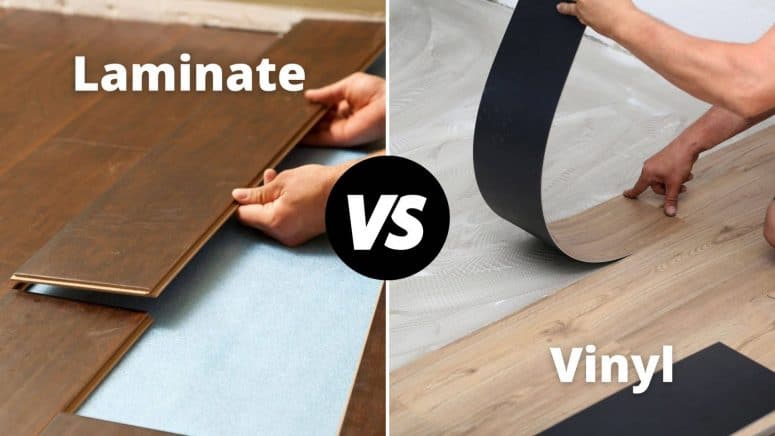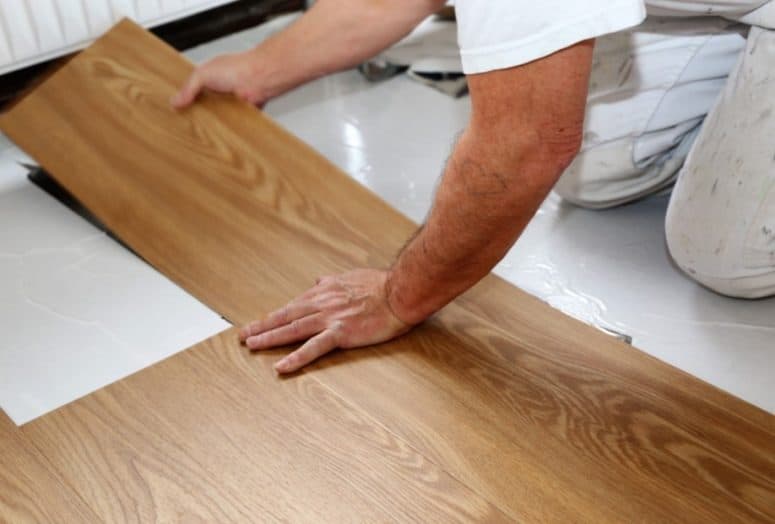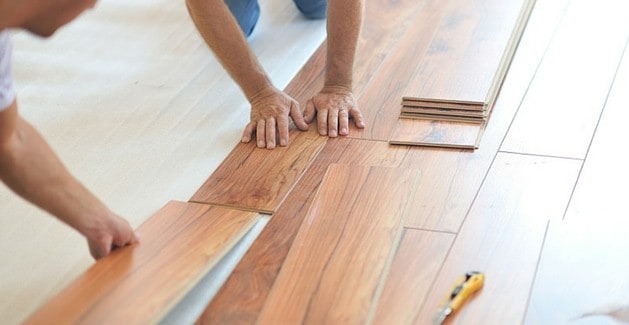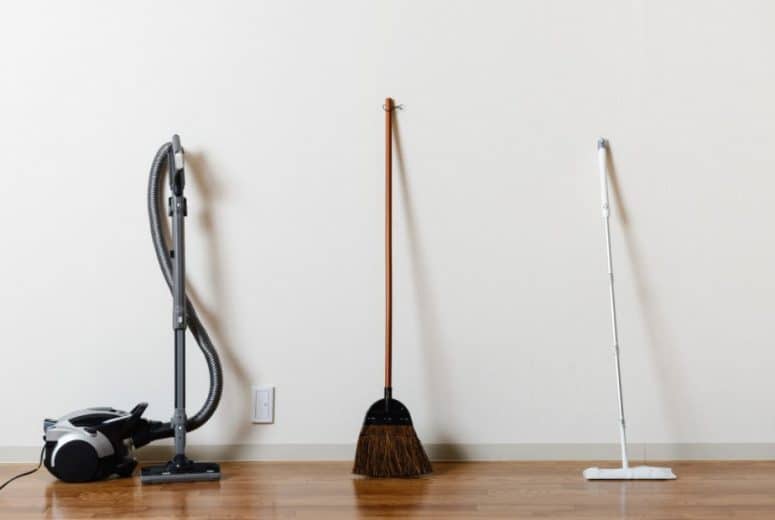Understanding these differences becomes imperative when making an informed flooring decision that aligns with your specific needs and preferences.
So, stay with us, as we delve into the comparison of vinyl versus laminate flooring!
Key Differences

To kick things off, it’s important to highlight key distinctions that unequivocally establish vinyl and laminate flooring as distinct entities.
Let’s commence by delving into their fundamental composition. What materials constitute these flooring options?
Vinyl Flooring Materials
Broadly speaking, vinyl and laminate exhibit fundamental differences in their composition.
Vinyl is predominantly crafted from synthetic materials, with PVC (Polyvinyl Chloride) as its principal component. Within vinyl flooring, multiple layers lie beneath the wood-like surface appearance.
In the manufacturing process, factories typically employ fiberglass as the foundational layer, subsequently applying a PVC coating for the finishing touch.
All the layers within vinyl consist of no-wax polyurethane materials, coming together to create the sheet-like structure of luxury vinyl tiles or planks.
Interestingly, vinyl flooring has the remarkable ability to closely emulate the appearance of authentic hardwood while, in reality, remaining a distinct entity.
Laminate Flooring Materials
In contrast, laminate flooring shares many similarities with vinyl when it comes to their specifications. However, what sets laminate flooring apart from vinyl is the core material used in its construction.
Frequently referred to as “floating wood tile,” laminate flooring is meticulously crafted by compressing a high-density blend of natural components, such as wood byproducts, into a single, visually appealing plank for your flooring needs.
Essentially, laminate flooring is primarily composed of wood, at least in terms of its visual presentation. The wood-like, stone-like, or other similar appearances are created through printed photographs beneath the wear layer on the floor’s surface. This gives it a semblance of real hardwood at times, although it remains distinct.
Both vinyl and laminate flooring feature distinct core materials, and although the disparity may not be glaring, these differences are the cornerstone of the varying specifications inherent to each type. These core materials dictate their respective water resistance capabilities, scratch resistance, and other vital characteristics.
Pros and Cons
Here’s a truth table that allows for a direct comparison between vinyl and laminate flooring across several crucial criteria:
Floor Type |
Pros |
Cons |
| Laminate Floor |
|
|
| Vinyl Floor |
|
|
Looks
When it comes to making purchasing decisions, aesthetics play a significant role in capturing one’s attention and piquing their interest. Flooring choices are certainly no exception to this rule.
So, when it comes to the visual appeal, which option between vinyl and laminate flooring best aligns with your preferences?
Vinyl Flooring Appearance
When it comes to this aspect of the comparison, vinyl emerges as a strong contender. Vinyl, especially in the form of Luxury Vinyl Tile (LVT) and Luxury Vinyl Plank (LVP), boasts a remarkable diversity in patterns, colors, and even designs, thanks to its synthetic composition.
Moreover, Luxury Vinyl Plank (LVP) offers a solid texture akin to genuine hardwood. Notably, a realistic photograph is delicately coated atop the vinyl surface, enhancing its natural appearance as if it were authentic hardwood.
Nonetheless, the aesthetic qualities of vinyl come with their own set of advantages and disadvantages.
Advantages:
- Vinyl flooring features a transparent top layer, concealing a high-quality photographic layer underneath that can convincingly mimic a wide array of materials.
- Luxury vinyl represents a modern construction that not only imparts a glossy sheen to your floors but also demands minimal maintenance. The best part is that this look can endure for many years.
Disadvantages:
- In some instances, vinyl can still appear somewhat synthetic, resembling a coated plastic on the floor when compared to genuine wood materials.
Laminate Flooring Appearance
Laminate flooring appeals to those who prioritize a natural aesthetic above all else. While it may not match the authenticity of genuine hardwood, it stands as an excellent alternative, especially under specific considerations.
The presence of embossed multi-dimensional elements on its surface contributes to a remarkably realistic appearance. Similar to vinyl flooring, laminate comes with its own set of advantages and disadvantages.
Advantages:
- When it comes to serving as a substitute for hardwood flooring, laminate leaves little to distinguish it from the real thing. This versatility extends to replicating various other materials, effectively accommodating different preferences.
- Laminate flooring boasts a long-standing presence, and its manufacturing techniques excel at replicating the textures of different materials while maintaining a smooth, laminated surface.
Disadvantages:
- In terms of visual likeness, laminate closely resembles hardwood. However, this close resemblance can occasionally make it challenging to differentiate between the two, potentially causing some individuals to lose interest.
The Winner: Laminate
When examining the diverse range of options available in both vinyl and laminate flooring, it becomes evident that many of them attempt to mimic the appearance of hardwood or natural elements such as stone.
In terms of presentation, laminate flooring tends to offer a superior texture and a more authentic visual representation compared to vinyl. While vinyl does offer a wide array of designs, it can sometimes come across as overly synthetic in its appearance.
Water Resistance
When contemplating a flooring purchase, the most common concerns revolve around water spills and moisture.
In the realm of addressing these concerns, which option do you believe stands out as superior—vinyl or laminate flooring?
Vinyl
Vinyl flooring has a remarkable advantage: the entire production process ensures its robust waterproof quality, whether it’s in the form of sheets, tiles, or planks.
Many individuals are opting for vinyl flooring in their bathrooms, laundry rooms, or even in humid environments like basements, which attests to its versatility.
What’s more, vinyl flooring is available in a variety of sizes. For instance, sheet vinyl comes in 12-foot rolls, facilitating seamless installation.
Interestingly, you have the flexibility to customize the size of the sheet vinyl and submerge it if needed—a feasible option! This feature makes it an excellent choice for areas prone to moisture.
Laminate
Laminate flooring doesn’t particularly strike my fancy when it comes to wet rooms, in my humble opinion. It’s acceptable and can be done, but there’s a catch.
You’ll need to consistently monitor the flooring for any lingering signs of moisture or water on the surface to prevent it from causing the fiberboard core to warp. Wondering why?
Well, that’s because laminate flooring demands immediate cleaning or wiping in the event of a water spill. It simply can’t handle water beyond a certain point in time.
Nevertheless, ongoing advancements in construction methods are bolstering the water-resistant properties of laminate flooring. While this transformation is still underway, many of these laminates can manage moisture effectively with proper installation, as a noteworthy point.
Ultimately, the natural fiberboard underneath the surface can soak up water if there’s a spill that lingers for an extended period. This explains why laminate flooring boasts water resistance on the surface but not beneath it.
The Winner: Vinyl
Vinyl is an unwavering champion when it comes to water resistance. Regardless of the specific type of vinyl flooring you select, they all boast 100% waterproof qualities, making vinyl a reliable choice even for moisture-prone areas like your bathroom.
Furthermore, the range of sizes available for vinyl flooring and the seamless installation of sheet vinyl are additional factors that bolster vinyl’s position in this aspect of comparison.
Ease of Installation
Determining the suitable flooring option often hinges on the installation process, which can significantly influence your choice.
So, which flooring option is more beginner-friendly and favored by contractors?
Vinyl Flooring Installation

Sheet vinyl, on the other hand, can be a bit challenging for beginners. The material is heavy, typically rolled to specific sizes, and requires meticulous installation to ensure a seamless look across the entire room.
Many individuals struggle with cutting sheet vinyl accurately, resulting in a messy, wrinkled appearance at the edges or even in the middle of the floor. It’s advisable for beginners to enlist the help of a professional when installing sheet vinyl.
However, DIY enthusiasts often opt for LVT or LVP due to their versatility in installation. These options include:
Peel-and-Stick Tiles: Luxury vinyl tiles can be applied directly by peeling off the backing and sticking them onto a clean surface. Floating Floors: Vinyl can be installed without the need for glue or nails. An underlayment can provide insulation and reduce footstep noise. Additionally, the click-and-lock feature ensures neat and secure seams. Glue-Down: You can choose to install LVT or LVP on a prepared subfloor by applying adhesive to the surface before placing the vinyl material.
Laminate Flooring Installation

While the installation process shares many similarities with vinyl, upon closer examination, you’ll notice subtle differences.
Laminate flooring can be installed using the peel-and-stick or glue-down methods as well. However, for floating floors, the procedure varies slightly. Laminate flooring can be installed by clicking and snapping the planks together without the need for nails or glue. For added convenience, you can opt for a foam underlayment, which can be included with your purchase.
The Winner: Tied
Both laminate and vinyl flooring, particularly in plank and tile forms, exhibit remarkable similarities. When it comes to choosing between them, it’s safe to say that the comparison between these two options is quite balanced.
Maintenance

To maintain high-quality flooring, proper care and maintenance are essential. When it comes to maintenance, including cleaning and repairing, it’s crucial to compare different flooring options. Let’s explore how vinyl and laminate flooring fare in terms of cleaning and repairing.
Cleaning:
Vinyl:
Vinyl flooring, known for its excellent waterproof properties, is relatively easy to clean. It can be cleaned with a simple sweep, mop (both dry and wet), or even with the use of a recommended cleaning sponge or products.
Pros:
- Synthetic construction provides a smooth surface, making it easy to wipe away water spills and preventing quick dust buildup.
- Regular cleaning requires only light vacuuming and occasional TLC with specific cleaners.
- Typical cleaning products for vinyl cost around $20 per gallon or $8 for a 32-oz. spray bottle.
Cons:
- Textured vinyl flooring may require more effort to remove food particles or stubborn dust from the grooves.
Laminate:
Laminate flooring is best suited for dry cleaning methods. If you opt for wet cleaning, be sure to use an almost-dry mop to prevent excessive moisture.
Pros:
- Laminate flooring boasts a smooth surface that makes cleaning up water spills and dust a breeze.
- Regular maintenance involves light vacuuming and periodic deep cleaning with cleaners, which may cost around $20 per gallon.
Cons:
- Textured laminate flooring may pose challenges when attempting to remove dust or food particles.
Repairing:
Anticipating potential repairs is an important consideration when choosing between vinyl and laminate flooring. Let’s explore which option might require more extensive repairs.
In terms of repairing, which one presents more challenges?
Vinyl:
Vinyl flooring is generally resilient and may require minimal repairs over time.
Laminate:
Laminate flooring, while durable, may require more extensive repairs due to its layered construction, which can be vulnerable to water damage.
In summary, both vinyl and laminate flooring have their unique cleaning and repair considerations. Vinyl is relatively easy to clean with its smooth surface, while laminate can also be cleaned effectively but may require more attention when it comes to repairing potential damage. Ultimately, your choice should align with your preferences and lifestyle.
Repairing
Vinyl Flooring:
Despite all the durability attributes of vinyl flooring, the occurrence of delamination remains a possibility, leading to potential loosening of planks or tiles.
Pros:
- Vinyl is inherently durable and can withstand regular cleaning routines such as sweeping, mopping, and recommended vinyl treatments.
Cons:
- Extensive scratching may necessitate sanding and subsequent refinishing.
- If delamination occurs, the entire set of planks must be replaced.
Laminate Flooring:
One significant factor contributing to the wear and tear of laminate flooring is its layered construction, which can lead to water absorption and warping.
Pros:
- Laminate flooring thrives with regular sweeping and the use of manufacturer-recommended cleaning products.
Cons:
- Excessive exposure to sunlight and water can significantly reduce its lifespan.
- The wear layer or coating cannot be refinished; instead, it requires complete replacement if damaged.
The Winner: Vinyl
I concur that both flooring options are straightforward to clean, thanks to their smooth surfaces.
However, it’s worth noting that vinyl flooring offers greater flexibility when it comes to cleaning, accommodating both wet and dry methods without causing any harm to the floor whatsoever.
Durability
When you invest your hard-earned money in a product, the desire for longevity naturally arises. Nobody wishes for their possessions to have a shorter lifespan than anticipated.
In this context, the question arises: which flooring option, vinyl or laminate, offers greater durability and a longer-lasting performance?
Vinyl
Over time, all vinyl flooring may eventually experience delamination, resulting in the loosening of the adhesive base underneath. However, the advantage lies in its suitability for high-traffic areas.
Typically, you can expect a warranty of 15 years or more when making a purchase.
Moreover, you have the option to prolong the lifespan of your cherished vinyl flooring by applying a urethane coating to reinforce the wear layer during installation.
Laminate
Laminate flooring certainly boasts durability; however, its robustness is somewhat compromised by its layered structure, rendering it susceptible to water warping.
The prolonged presence of water within the laminate flooring can expedite wear and tear.
The typical 20-year durability guarantee often translates to only half of the expected lifespan.
Moreover, laminate flooring lacks additional coatings or finishing varnishes, leaving it with just one wear layer for defense within your home.
The Winner: Vinyl
Vinyl and laminate flooring both possess commendable durability; nevertheless, they are not entirely impervious to wear and tear.
In particular, vinyl flooring stands out for its remarkable durability, thanks to its resilient nature and ability to withstand the demands of high-traffic areas.
Cost

Now, let’s delve into a crucial consideration that necessitates your attention before embarking on the decision between vinyl and laminate—your budget.
Vinyl Flooring Cost
Typically, glue-down vinyl flooring starts at a base rate of $1.00 per square foot. However, this cost can increase substantially, reaching up to $5.00 per square foot for luxury vinyl planks (LVP) and certain renowned vinyl brands in the market. Here’s an outline of the cost spectrum for vinyl flooring:
- Low: $2 per square foot
- Mid: $5 per square foot
- High: $7 per square foot
It’s advisable to allocate an additional $3-$10 per square foot for installation charges.
Laminate Flooring Cost
In contrast, laminate flooring typically starts at around $1.00 per square foot for 7mm-thick planks. However, it’s important to keep in mind that this cost multiplies based on the area you need to cover. Here’s a breakdown of the cost range for laminate flooring:
- Low: $1 per square foot
- Mid: $2.50-$4 per square foot
- High: $5 per square foot
Additionally, it’s advisable to allocate an additional $3-$10 per square foot for installation expenses.
The Winner: Tied
When it comes to pricing, both laminate and vinyl find themselves in a closely matched comparison. These alternatives to genuine hardwood offer an enticing blend of affordability and practicality, making them more budget-friendly options in contrast to real hardwood.
Environmental Effect
While laminate flooring is often lauded for its eco-friendliness, it’s important not to cast vinyl flooring as the villain in this comparison.
There exists a variety of vinyl flooring that boasts environmental friendliness on par with the principles that underpin laminate flooring. So, keep reading to explore this alternative!
Vinyl Flooring
As the world progresses, numerous factories and vinyl flooring manufacturers are continually improving the quality of their products.
Vinyl has recognized the importance of eco-friendliness, earning a LEED credit EQ4.3 for Low-Emitting Materials.
Nonetheless, it’s crucial to acknowledge that vinyl is predominantly composed of synthetic materials, and when incinerated, it yields toxic chemical residues.
Furthermore, vinyl doesn’t readily degrade in landfills, and recycling vinyl isn’t a widely adopted practice.
Laminate Flooring
Indeed, numerous laminate flooring manufacturers provide products that meet the criteria for LEED MR4 (Recycled Content) certification.
However, it’s important to note that laminate flooring is not entirely without its environmental concerns. It still incorporates plastic materials on its surface, and the utilization of melamine resins in its production may result in the emission of potentially harmful chemicals.
The Winner: Laminate
When weighing the environmental impact in terms of benefits and drawbacks, the fiberboard core employed in laminate flooring takes the lead in the race toward eco-friendliness when juxtaposed with vinyl flooring, a wholly synthetic material.
Furthermore, when considering waste disposal, it becomes evident that vinyl flooring generates a heavier waste footprint compared to laminate. This discrepancy arises from vinyl’s limited potential for recycling, resulting in greater waste accumulation when it is discarded or incinerated.
Which Floor Is Best for You?
Now, who emerges victorious in the battle of vinyl versus laminate?
The answer ultimately lies with you, as individual preferences play a pivotal role in selecting materials for your home decor and lifestyle choices.
If your inclination leans toward the more eco-friendly option, laminate or other suggested alternatives might be your go-to.
If you’re a DIY enthusiast seeking ease of installation, assess which one aligns best with your DIY aspirations.
In situations where robust water resistance is a paramount concern, exploring vinyl or other recommended options might be your best bet.
For thoughtful decision-making, it’s prudent to weigh the pros and cons of the choices you’re considering. Evaluating the advantages and disadvantages of household purchases is a prudent practice.
In the context of this comparison, if you’re uncertain, consider ordering free samples of both vinyl and laminate for a hands-on, real-world assessment.
Ultimately, after careful deliberation, you’ll arrive at a well-informed decision that aligns with your specific needs and preferences.